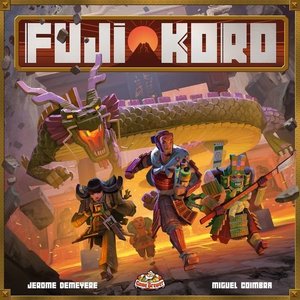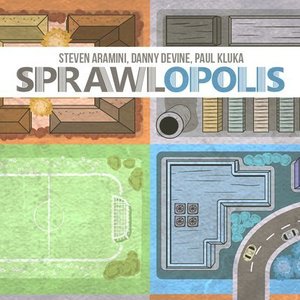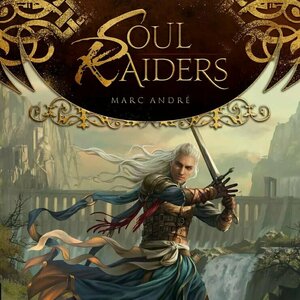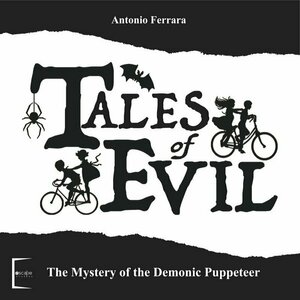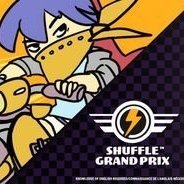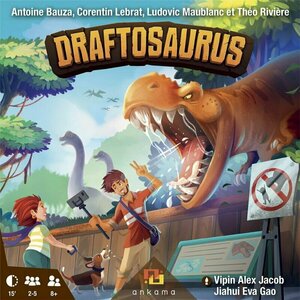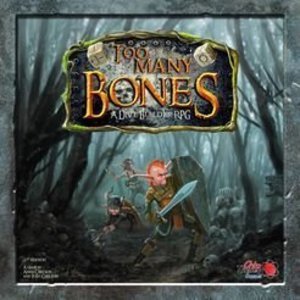
Too Many Bones
Tabletop Game
Too Many Bones comes loaded for bear by breaking into a new genre: the dice-builder RPG. This game...
Boardgames DiceRPGgame
Purple Phoenix Games (2266 KP) rated Sprawlopolis in Tabletop Games
Jun 12, 2019
If you had the chance to design a city, how would you do it? Would you have a park on every block for some nice greenery, or do you think a large commercial district will bring in more people? What about housing – would people live right in the heart of the city, or would they live more on the outskirts? The day has finally come where those decisions are up to you! Well, mostly. You’ve been hired to help design the ultimate city! The city officials have given you some specific requirements, but beyond that, the plans are up to you! Can you meet their needs while also maximizing your space? It’s time to put your skills to the test and build the best city ever!
Sprawlopolis is a cooperative card placement game of only 18 cards. Given 3 random scoring conditions, you must draw and play cards into the city to fulfill those requirements. Meet or exceed their score, and you win the game! Fail to do so, and you have not succeeded in building the city up to specifications. Be careful how you decide to place your cards, however, because depending on the scoring conditions in play, certain placements could result in negative points at the end of the game. Working together, you and your team must decide which cards to play at what time to ensure that the requirements are all met. Solo play is identical to cooperative play, except that you just always have a hand of 3 cards from which to play. The score to beat each game is dependent on the scoring conditions, so this game isn’t just another beat-your-own-high-score game – you actually have a specific number in mind.
For a game with only 18 cards, there is a lot of variability in Sprawlopolis. I have yet to play 2 identical games. The layout of each card is unique, as are all of the scoring conditions, so the possibilities are endless… almost! I also enjoy playing this game solo because it requires a decent amount of strategy. Three things factor into your final score (the scoring conditions, block groupings, and roads) and it is impossible to succeed by focusing on only one of them. Your strategy is always changing based on the cards in your hand, and you really have to think about how to best utilize each card for maximum end-game points. Depending on when and where you play a card, it could change the entire city so you have to be thinking about the big picture, literally! And a neat thing about Sprawlopolis is that you can overlap cards. So maybe a card you played earlier is not really ideal anymore, given your current hand, so you can just cover up either a portion of it or the entire card!
The hardest thing about Sprawlopolis for me is that certain combinations of scoring conditions can be difficult to complete. One may give you points for a certain type of city block, but then another may take away as many, or more, points for that same type of city block. Or one gives you points for certain roads, but all roads result in negative points during end-game scoring. Since the scoring conditions are chosen randomly, there’s not really a way to negate this unless you just re-draw those cards. You usually can’t just look at a scoring condition combination and know if it will be difficult or not either – you just have to try it. I’m not saying they’re impossible necessarily, just harder to successfully complete.
Overall, I think Sprawlopolis is a neat game. It’s fast and easy to learn, yet strategic enough to keep you coming back for more games. I like to use it as a nice light filler game between some bigger games, or I just like to play it if I’ve got a quick 15 minutes to spare! Sprawlopolis is a fun game to play with a group, and it’s also a fun game to play solo. In my arsenal of solo games, it’s definitely one on standby.
https://purplephoenixgames.wordpress.com/2019/02/11/solo-chronicles-sprawlopolis/
Purple Phoenix Games (2266 KP) rated Soul Raiders in Tabletop Games
Jul 5, 2021
Soul Raiders is a storytelling role-playing game for up to four players. Each player takes the role of an aspiring Soul Raider tasked with saving the realms from the influence of evil. The game is played over several sessions that all affect the overarching plot of the narrative, but this preview version simply allows players to learn the game mechanics through a prologue scenario.
DISCLAIMER: We were provided a prototype copy of this game for the purposes of this review. These are preview copy components, and I do not know for sure which final components will be different from these shown. Also, it is not my intention to detail every rule in the game, as there are just too many. You are invited to download the rulebook, back the game through the Kickstarter campaign, or through any retailers stocking it after fulfillment. -T
To setup, follow the instructions in the rulebook. There are too many to list here. Once setup, the play area may look similar to the photo below.
As there are 36 pages in the preliminary rulebook, I am unable to detail everything in this preview. However, I can give an overall gameplay feeling.
Players control pawns (standees in this version, but plastic minis in the final) that will adventure on Location tiles that spawn baddies, traps, and other elements. Each round played has no turn structure; players can take their actions however they like in any order, and sometimes players will take actions simultaneously. Once all players have taken their actions, the baddies will attack (though some attack immediately upon spawning in a Location as well).
Combat is resolved through clever chaining card play. The cards drawn to the players’ hand are multi-use and can be combined with others in hand to pull off complex combos. All players will have access to melee combat cards, movement cards, and also magic spell cards. Utilizing the cards efficiently, as well as leveraging each players’ inherent strengths, can make or break combats and skill checks throughout the game.
In addition to the myriad combats players will face, they will also be able to encounter events, special characters, and traps. Many times these will result in skill checks or other card shedding activities in order to progress the story.
Throughout the game a tracker board constantly keeps players aware of the current vitae of the party (collective health), threat level, and active events. Players will also be using personalized player boards to keep track of their deck of cards, active engaged enemies, and status tokens. Each character has special talents different from each other, and the final game will have at least four characters, whereas this version has two.
If the players can navigate the game efficiently and quickly enough to satisfy the win conditions, then victory is to be shared. However, if you, like me, are still trying to figure out how to win, the game ships with an interesting session saving ability so you can pick up where you left off with any combination of players and characters.
Components. Again, this is a preview copy of the game, and not everything is final. That said, I can see the direction this game is going, and if it results in a successful Kickstarter campaign, I foresee me praising the publisher for their excellent components. Most of the art seems complete, and the character art is so amazing. In contrast, I feel the landscape art doesn’t necessarily match the intensity and details given in the character art. It just feels out of place in an otherwise excellently-illustrated game.
The gameplay, however, felt very fresh and familiar at the same time. I have played several games where the players’ card decks offer multi-use cards in much the same fashion, and here in Soul Raiders, the cards can be played for their numeric values or their special abilities. What I like about this is the ability to use the cards in hand to pull off sweeping combos of insane damage, or to really nail the lockpicking difficulty checks. There will be times the heroes will need to be engaged in combat with four or more enemies, and having certain spells that can wipe out most of them with one card is always very satisfying.
Movement has largely been neglected in my plays of Soul Raiders, as I haven’t found a great way to make it sing as a card type. Players will need to use movement to travel from one Location card to others, but there are also mechanics in place for the heroes to flee away from battles. I have yet to feel the need to flee from battle. I also have yet to truly understand the need for a big selling point for the game – character invisibility. Yes, I can see how being invisible would be a great benefit, but I rarely had the ability cards in hand to use it properly or effectively. I am told, though, that the game will ship with both a normal character mini and a transparent mini to indicate when they are invisible. So there’s that.
All in all I really do enjoy the storytelling gameplay of Soul Raiders. I think this intro prologue scenario has piqued my interest and triggered my desire to play more in the story. I hope that some adjustments will be made to make invisibility and fleeing more important aspects of the game, but for now I am ignoring them almost systematically. That said, if you are looking for a new game with a great theme and some pretty good mechanics, I invite you to check out the Kickstarter campaign launching very soon. I think this would be a great one to have in a collection, especially as I can see it being infinitely expandable with new books of scenarios and small expansion packs with new heroes, etc.
Purple Phoenix Games (2266 KP) rated Tales of Evil in Tabletop Games
Oct 1, 2020
Tales of Evil is a cooperative, horror, storytelling, adventure game that uses a unique new “Fusion System” throughout the game. Players will be taking on personas of kids from the 1980s who belong to a club named “Pizza & Investigation.” I do not wish to reveal too much in this review, so I will be covering this as a Solo Chronicles using one character going through the introductory tutorial mission.
DISCLAIMER: We are using the Kickstarter Deluxe version of the game. We do have the expansions from the KS campaign, but will not be using those for this review. Also, we do not intend to cover every single rule included in the rule book, but will describe the overall game flow and major rule set so that our readers may get a sense of how the game plays. For more in depth rules, you may purchase a copy from the publisher directly or from your FLGS. -T
To setup, well, just follow the setup instructions in the rulebook. There’s too much for me to explain here. For one character playing the tutorial scenario, the game setup should look similar to what is pictured below. Maybe. The rulebook does not specifically state WHERE each item should be placed, so players will have ultimate freedom to setup items where they see fit to be most efficient for themselves.
Players in Tales of Evil will have no real “turn structure” as most games do, because all players will be adventuring together as a group. So characters will be moving as a group and never splitting the party (RPGers breathe a sigh of relief… maybe). However, as with many adventure games of this style, once players explore into new areas certain markers will placed on the board (Clue, Darkness, Mystery, Search, etc). These markers signify different actions that can be taken, or entrances to areas that are blocked or found, or something that could be traced from one area to another. The leader of the group for the time being is in possession of the Walkie-Talkie and will make all final decisions for the group after any discussion (for solo players, it is just a nice prop). Usually searching for items will result in a card draw and upon the card will be a test to pass using the stats on the player character mat to roll dice for successes. Of course, the other side of that are horrible losses as well.
Players will be traipsing through the area and reading passages from two actual books: the Story Book and the Event Book. Most of the action happens in the Story Book and it will guide players through the story and once choices are made or tests succeeded/failed, the book will instruct players what to do next and to which section to turn to further the story (a la Tales of the Arabian Nights). The game continues in this fashion until the story ends with victory or defeat.
Components. Why yes, that is a real spoon in the photo above. No, it does not come with the game. I will explain in a bit. The components in this game are great. Each character has their own mat for organization, action cards, equipment cards, and status cards that dictate the difficulty of the game and how the character degrades over time in the horror-filled mission. Some components are even glow-in-the-dark! A nice touch, but certainly unnecessary. I find everything to be wonderful quality, even the cards that are kind of polarizing on the KS comments are nice (people are complaining that they are not linen-finished, but I believe the publisher made the right call to make them matte finished if the linen obscured the look and art on them). Thumbs up for components from me.
I wanted to wait until my final thoughts to explain the whole “Fusion System” that is in play here. Tales of Evil uses the catchphrase, “You will get into the game and the game will get into you!” Now, I’m not sure exactly how this game is getting into me, but I’m certainly digging the game and this Fusion System. You see, some cards (in the tutorial, remember, so I’m not really giving much away here) will give players 60 seconds to grab a kitchen spoon for some benefit and a debilitation if they are unable to find one – hence the spoon in my photos. Another card relies on the character (and also then the player) removing their shoes. Still yet another deals with fire or people smoking in the vicinity. If there is fire nearby in real life, it affects the effects of the card drawn. It’s ingenious and I love every little bit of it! I can’t wait to see how the Fusion System will work in this game more and how it can be applied to other games in the future.
All in all I love everything about Tales of Evil. The setting is great, the Pizza & Investigation kids are awesome, and the game itself is incredibly engaging and makes you really think about the choices you make within. Perhaps the haunting feeling of doubting some choices is how the game gets into you, because I did find myself wondering what would have happened had I chosen a different course for some instances. I am very drawn to this game and I want to tackle all of the scenarios. Even solo! And another great thing about Tales of Evil is the fact that a player (or players) can join a game already in progress! So if I am exploring solo and my wife decides she wants to hop in, she just grabs a character mat, sets up the character, and dives right in with me. I LOVE games like that. So versatile.
While I should probably stop gushing at this point I just can’t. This game is so much fun and worth every penny spent on it. I implore you, if you are a fan of exploration adventure games in this vein you definitely need to snatch up a copy whenever you see one. And if you love it as much as I do let me know. We can swap adventure stories.
Oh did I mention the designer is even created a way for us normies to create our own scenarios and upload them to other Tales of Evil players? Yeah, I’m fascinated by that as well…
Purple Phoenix Games (2266 KP) rated Shuffle Grand Prix in Tabletop Games
Jun 12, 2019 (Updated Jun 12, 2019)
DISCLAIMER: While I will not be delving completely into the rulebook and describing every rule and scenario, I will give you a good idea of how the game plays and what I think of it. -T
Okay let’s setup this game in our minds. Shuffle the large deck of Distance Cards (in denominations of 25, 50, 75, and 100 distance) to form a draw deck. Each player will draft a team of racer and co-pilot, which means taking the racer’s deck and co-pilot’s deck to form their team. Each pilot is a different character with different decks and different special abilities that can be used throughout the game. For example, my first team was the wizard and the musician. Place the driver’s character card on top of the wheel (health) card at maximum wheel strength, and tuck the co-pilot’s card underneath them. You cannot use the co-pilot’s ability until they become the driver (when your main pilot spins out due to your opponents and their dastardly play). Now shuffle the driver’s and co-pilot’s decks together (a la Smash Up) to form your personal draw deck, draw three cards, and you are ready to begin!
On your turn you will flip over the top Distance Card and place it in front of yourself. This is how far you have driven this turn, and ultimately is your VP stack. From there you may play cards from your hand to affect your own cards, the cards of your opponents, or place traps. You may equip items to your car (max 2), switch out equipment, or pass your turn ? This structure continues until there are no more Distance Cards to draw, then the game ends and you count Distance to see who is the winner! I have intentionally left some rules out because they are fun to discover and play – like making your opponent spin out (for trophies), nerfing your opponents, card combo play, etc.
Components: this game is relatively light on components as it is a large number of playing cards and a collection of trophy chits. The chits are good quality, and were definitely too numerous for our plays. The cards are of great quality, which is what you expect from Bicycle, the playing card giant. The art in this game is VERY quirky. I wouldn’t say the art is amazing, but it’s fun and fits the theme. Think Munchkin art. In fact, think of this game as a whole as a combination of CTR/Mario Kart meets Munchkin.
Overall, I really dig this game. It’s pretty fast-playing, though those AP-prone players will hold up the game a bit on their turns. The rules are light, the game play is really fun, and the flavor text on the cards is quite humorous. I thought out loud as we were playing that this is a replacement for Munchkin for me, and I like Munchkin a lot. The take-that/screw-your-neighbor aspect is certainly there, but even when you pile on it doesn’t seem to slow you down so much that you can no longer do much on your turn. I appreciate that. The eight provided playable character decks feels like I can play this game for a really long time with different combinations and enjoy it each time. So for the ease of play, enjoyment of play, different combos we are excited to try, and absolute silliness, Purple Phoenix Games gives this one a bashin’ 14 / 18. Check it out!
https://purplephoenixgames.wordpress.com/2019/06/06/shuffle-grand-prix-review/
Purple Phoenix Games (2266 KP) rated Draftosaurus in Tabletop Games
May 14, 2021
Draftosaurus is so appropriately named due to being a drafting game with a dinosaur theme. Instead of typically drafting cards, however, players are drafting adorable little dinomeeples to populate their theme park attractions. Each attraction, or pen in the game, offers different points for having different dinos in each, or the same, or just one, or exactly three, et al. The player with the most points from these pens at the end of the game is the winner!
To setup, every player receives a park board. Populate the draw bag with dinomeeples based on the number of players using the table in the rulebook. Give the wooden placement die to the youngest player and play can begin!
A game of Draftosaurus spans exactly two rounds. Each round is exactly the same: each player grabs six dinomeeples from the bag, active player rolls the die, players draft dinos, players pass the remaining dinos. Repeat these steps starting at die rolling, but the die is passed along with the dinos from the active player. This is repeated until all dinos have been drafted and placed in pens. Easy right?
The true nature of the game and the most fun part is in the placement die and placement of the dinos in the pens. When the die is rolled, this signifies specific placement rules for all players except the active player. So perhaps the die shows that dinos must be placed in the Grasslands, which are the pens on the bottom portion of the boards. Or maybe the die shows that new dinos may only be added to pens that currently have no dinos in them. Again, these rules do not apply to they that rolled the die, but rather every other player. Herein lies the scrumptious struggle: where does one place the dinos they currently possess in their hand from their neighbor? What pens will score the most points at endgame? Can a T.Rex really be appropriate in this pen? The choices can be maddening, or one can play the game with complete laissez-faire and still have a great time. After two rounds the game ends and players look upon their parks with pride as they count up their final scores.
Components. I really only know Ankama from the Krosmaster games, which though I am not really a fan of, the components are great. I believe Ankama has provided excellent components for Draftosaurus. The dinomeeples are all excellently colored and designed. The boards are good quality, though I question the “Grasslands” being brown and kinda devoid of grass. All in all, the components are great and I love handling them and playing with them.
Yes, we always include our scores at the beginning of each review. So you all already know what I’m about to say here. I love this game! I love having so many options available to me, only to have the die roll tell me I can’t do exactly what I want, so I have to alter my strategy on a dime. I love being able to see my dinos filling up the park (or swimming in the River if there are no places for them) and watching them frolic… well, okay not frolic in tight spaced pens. No wonder they all went crazy and escaped in those movies. In any case, if you or your family/friends/playdates enjoy drafting games, but want something a little different, while respecting your playtime (something that many drafting games extend) take a look at Draftosaurus. Even children can get in on the action, as there is no need to be able to read, necessarily. I haven’t yet tried it with my 3-year-old, but I think I will this weekend now. That all said, Purple Phoenix Games gives this one an enthusiastically Triassic 19 / 24. Just keep Newman and Nick Fury away from your game table.
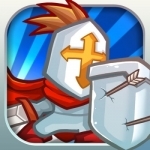
Frontier Defense
Games, Entertainment and Stickers
App
Embark on an epic defense at frontiers to grow ever stronger and defeat your insane enemies. Hold...
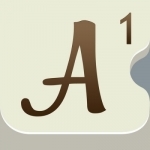
Aworded Crack (Apalabrados)
Games and Entertainment
App
FROM THE CREATORS OF TRIVIA CRACK! Aworded Crack is an addictive word game that has already...
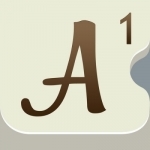
Aworded Crack (Ad Free)
Games and Entertainment
App
FROM THE CREATORS OF TRIVIA CRACK! Aworded Crack is an addictive word game that has already...
